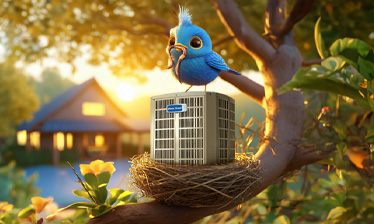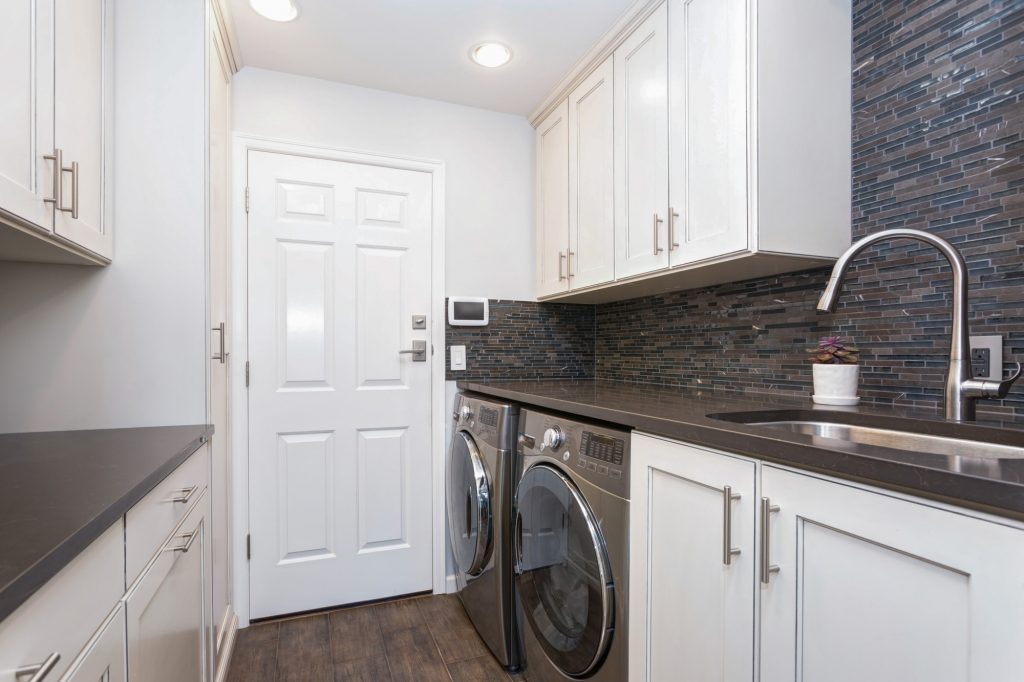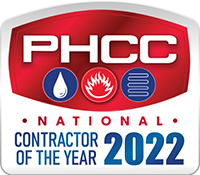

The average washing machine uses 41 gallons of water per load. If you’re a typical family of four with active kids and adults, you may find yourself washing two loads of laundry a day. In that case, you’re cycling 82 gallons of water through your machine daily. That’s a lot of water to run through in one room.
Basic maintenance and a few creative tips can keep your laundry room plumbing running efficiently and smoothly. Keep reading to learn how to manage laundry room plumbing properly.
Laundry Room Plumbing Specifics
Laundry room plumbing differs little from other plumbing setups. Unless your home uses geothermal techniques that add extra pipes under the floor, the plumbing in your laundry room will have the same basic elements as a bathroom with a few tweaks.
In particular, your laundry room should have a drain. Well-made homes have laundry drains on the floor in case you have excess water from a broken pipe or a malfunctioning machine. These drains along with a few extra exposed hoses give you the opportunity to be creative with the plumbing in this room.
1. Keep Your Hoses Intact
You should have a couple of different hoses attached to the back of your washing machine. These hoses can wear out after time. If your hoses are showing signs of wear such as cracks, begin looking for new hoses. Look for a high-quality hose in your search. You do not have to purchase the same kind of hose that you currently have.
Plumbers often recommend stainless steel braided hoses. Steel hoses do not break apart as typical rubber hoses do. They also can handle the strain of water pressure without breaking down as quickly as a rubber hose.
This Includes Supply Lines
Laundry plumbing consists of drains and hoses. People commonly find laundry plumbing problems near the back of their machine where the washing machine supply line exists. Keep an eye on those supply lines regularly. Every year when daylight savings time rolls around, make a mental note to check your supply lines. In particular, look for cracks, leaks, blisters, and bubbles in the line.
Examine the faucet and the washing machine carefully as well. You may just need to tighten a connection to avoid a fountain of unwanted water from flowing into the laundry room.
2. Washers that Don’t Wash
Check all of your washers when you check your hoses. The washer is a thin metal plate with the hole in the middle that goes between your hose and its connector. A metal washer will distribute the load of the fastener to which your hose is hooked. So if your hose is loose, the washer will make a rattling noise when your machine is going.
Take time to replace those washers since they can wear out over time and lead to leaks. They can also make some pretty obnoxious sounds if you do not care for them.
3. Laundry Drains
Your laundry room drain is a unique feature of laundry room plumbing. A well-made, purposeful laundry room will have a floor drain. While this floor drain is helpful for all laundry drainage purposes, you need to maintain it to prevent problems.
If your laundry room ever begins to smell like a sewer, flush your laundry drain. Gases in the pipes can back up over time and then seep into your laundry room. So instead of your room having that pleasant, fabric softener smell, it ends up smelling like the city sewage pond.
Fill a bucket with warm water and then slowly dump it down the drain. This will help flush the line and prevent bad smells from seeping back into the room for a while. Plan on flushing your drain once a month to keep sewer smells at bay. Examine your machine and its plumbing carefully. See if the machine feeds into a sink or directly into a drain. Then install a drain filter to catch debris that drains out with washing water.
Debris and lint in the washing water can clog your drain after a while, so a drain filter can catch those particles and hopefully prevent a backup of water. If flushing the drain does not fix your problem, you have other options. If the smell is coming directly from your washing machine, you can flush out your machine.
You can fix this by running the machine with a mixture of baking soda and vinegar. Not only will this get rid of the bad smell, but it will also clean your machine.
4. Strainers
If your laundry room currently has strainers, you’re well on your way to preventing problems like clogged lines and backup water. However, you need to maintain those strainers as well. Strainers will collect lint, hair, and anything else that could accumulate and clog your plumbing system.
Once a month, make a note of checking your strainers. Make sure they’re still working, and if necessary, clean them out. This will protect your laundry room and give you peace of mind.
5. Exposed Pipes
You will ultimately have exposed pipes behind your washing machine. You’ll have pipes in the wall to which your hoses feed as well. Secure your exposed pipes with rope or zip ties. This way, when your washing machine begins agitating, the pipes will not shake loose. Make sure all hoses are securely attached to the machine and the wall.
Clean your laundry room regularly. Doing will make you familiar with the area behind your machine, so if a pipe looks askew or off in any way, you will recognize a problem.
6. Laundry Sink
A laundry sink exists for a couple of reasons. You can do some handwashing in it, but your washing machine may also drain to it. If you have a laundry sink that you use regularly, check the laundry sink drain and sink itself for leaks or cracks regularly. Listen as you use it and run water. Strange noises could mean you need to check the metal washers on those connections as well.
If your laundry sink is draining slowly, break out a plumbing snake and clean the line. If you have a significant blockage, contact a professional to free your line and get your laundry plumbing back on track.
7. Rearrange the Furniture
You do have some choices when you arrange your laundry room. If you’re in the middle of a new laundry room build, you can arrange the washing machine, sink, and floor drain to help you avoid laundry room plumbing problems.
For example, make sure you have enough room in the laundry room. Your washing machine will not sit flush with the wall. Instead, pull the machine away from the wall so your supply lines have plenty of room. Make sure your supply lines are not kinked. Keep your appliances an inch or so apart to give them some space.
Also, make sure your washing machine is level. Your machine should have adjustable legs so it sits level with the floor and on an even surface. Your machine has the best chance of not malfunctioning or leaking if you have it on a level surface.
8. Look for a New Machine
If you want to run less water in your lines and reduce your water bills, then look for a new washing machine. In particular, look for a high-efficiency washing machine if you want to run less water in your lines. You will end up spending less money on water usage and on plumbing problems because your plumbing will last longer.
The average family does 8 to 10 loads of laundry a week. That means the average family has approximately 400 loads of laundry a year. When you use a high-efficiency washing machine, you’re running less water for those 400 loads of laundry, and you’re saving your plumbing.
Often your local water company or electrical company will offer rebates when you purchase a high-efficiency machine. So while the machine itself may cost you money initially, it will save you money. Plus, your plumbing will last longer.
9. Don’t Waste Water
Small loads of laundry are actually harder on your plumbing than big loads. You can use up to 40 gallons of water in one load. When you are washing a single pair of jeans with 40 gallons of water, you’re using your plumbing wastefully. If you absolutely need to have that one pair of jeans, scrounge around to find more laundry to fill the load.
Also, sort your laundry. Take time before you do laundry to sort it out so that you’re washing like items. This way you’ll end up with equally dry items after you throw them in the dryer. You’ll also reduce the likelihood of throwing your washing machine out of balance.
Consider not washing clothes every day. If you’re a single person or even just a couple, consider having laundry day one day a week to keep your laundry plumbing from being overrun. This way you’ll have full loads and clean laundry once a week.
10. Keep it Cool
Hot water takes energy and also wreaks havoc on plumbing. Laundry soap companies have developed laundry soap specifically for cold water washes, knowing that cool water will save energy and save your plumbing.
Up to 80 percent of the energy used to wash a load of clothes actually goes to heating the water. So if you wash your clothes with warm or cold water, you can save significant amounts of energy. Even just moving the dial over to warm will reduce your energy bill and usage.
Granted, some clothes need hot water. Your son’s filthy soccer uniform will come out grimy if you do not have adequate warm water to scrub off the dirt and grass stains. Even just a warm load should do the trick, though.
11. General Maintenance
You take your car in for regular maintenance to make sure a hose doesn’t spring a leak when you’re on the road. Your laundry room plumbing is no different. Arrange to have a plumber come in once a year to inspect your plumbing.
A trained eye will catch laundry room problems before they turn into catastrophic problems. Make sure you contact a professional plumber and not just the neighbor down the street who carries a wrench in his back pocket.
While having a plumber come in just to maintain your plumbing might seem like an extravagant cost, catching a problem early will save you money and the pain of remodeling from a disastrous leak. An ethical plumber will give you recommendations that you need.
12. Plan for Problems
If you’ve ever had plumbing problems, you know: they can happen to anyone. In addition to having a plumber come in regularly to inspect your lines and ensure everything is working as it should, you can also install a flood alarm. Flood alarms come at all sizes and prices. You can purchase a simple water-sensor for as little as $12.
The simplest alarms consist of a sensor that you put on the floor or in a place where you’d expect water to show up first. When water touches the sensor, the alarm blasts a high-pitched squeal until either the battery dies or the sensor is dry again.
More sophisticated alarms can hook up to your phone via Bluetooth. This way if you’re at work and a pipe bursts, you will receive a message that you have water on the floor of your laundry room. You do not have to wait until the end of the day to see your flooded home, but you can stop the problem before further damage occurs.
You can also prevent plumbing damage by adjusting your water heater settings. Keep the water no higher than 120 degrees Fahrenheit. Water that is too hot will ultimately damage the rubber washers in your hoses.
Laundry Room Plumbing Done Right
When you take time to maintain your laundry room plumbing, you end up with a dry, pleasant smelling room that keeps your clothes clean and ultimately saves you money. For all of your plumbing needs, contact us.

















